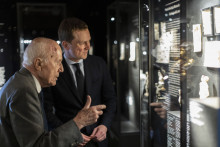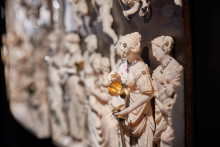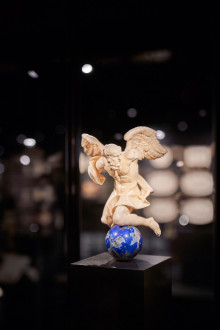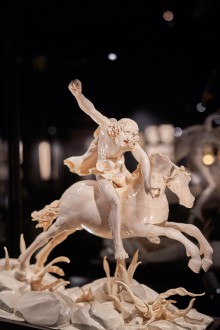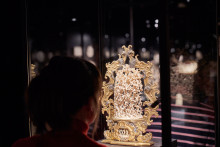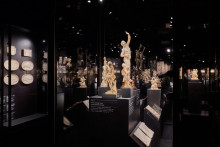Reiner Winkler was a successful building contractor, great music lover, world traveller, enthusiastic diver and mountain climber. He was also the world’s most important private collector of ivory. Over a period of thirty years, he amassed some 210 works of ivory, creating a collection of international renown. He had a passion for the precious artworks and delighted in every successful acquisition. “The idea of art as an investment never came up for me”, he wrote in 1984. He carefully studied auction catalogues and cultivated close contact to art dealers in Munich and Bremen, but also farther afield in places like London, Paris and New York.
Following the purchase of his first ivory—a small Gothic-era panel—in 1962, his keen interest in the material developed rapidly. From then on, however, it was ivory work of the seventeenth and eighteenth centuries—statuettes, figural groups, reliefs and vessels—that sparked his collecting zeal. His holdings were published in 1984 and 1994 in two inventory catalogues drawn up by the world’s leading ivory expert, Christian Theuerkauff, the “lucky star” of his collection, as Winkler called him.
The collection was originally on display in an underground display room and in Winkler’s home. He hospitably invited museum representatives to visit his “cabinet of curiosities” and was equally receptive to loan requests submitted to him by museums in preparation for special exhibitions. Presentations in Germany and abroad profited from this openness, among them the ivory exhibitions staged by the Liebieghaus over the years. In 2001/2002, for example, Winkler made fifty select ivories available for the travelling exhibition “Elfenbein: Einblicke in die Sammlung Reiner Winkler” (Ivory: Insights into the Reiner Winkler Collection) presented at the Deutsches Elfenbeinmuseum in Erbach, the Albertinum of the Staatliche Kunstsammlungen Dresden and finally the Liebieghaus Skulpturensammlung in Frankfurt.
“The Master of the Furies” followed in 2006, to which he contributed the pièce de resistance of his collection—the Fury on a Charging Horse of 1610—as well as a statuette of Eve and the figural group Elijah Awakened by the Angel attributed to the same sculptor or his workshop. In 2011, the Liebieghaus and the Kunsthistorisches Museum in Vienna jointly presented the exhibition “Ivory: Baroque Splendour at the Court of Vienna”, once again with masterworks Reiner Winkler generously placed on loan from his collection.
In 1995, in a gesture of his ever-exceptional generosity, the collector established the Reiner Winkler Stiftung, a foundation devoted to promoting research in the area of small-scale European sculpture of the seventeenth and eighteenth centuries. The same year, he announced his decision to donate a large proportion of his collection to the Liebieghaus, an institution to which he had had close ties for many years. The collector and the Städelsches Kunstinstitut, which oversees the sculpture collection, signed the donation agreement in July 2018. Soon afterwards, the artworks were transported from Winkler’s display room to the museum to make them accessible to the public in the exhibition “White Wedding: The Reiner Winkler Ivory Collection Comes to the Liebieghaus—Forever.”. The show featured 160 works from that collection along with 24 comparanda from the museum holdings. The opening ceremony took place on 26 March 2019 in the presence of the collector, his family, representatives of the sponsoring foundations and numerous ivory specialists from Germany and abroad. The fact that Reiner Winkler was able to attend this event fills us with gratitude.
Reiner Winkler died on 19 May 2020 shortly before his ninety-fifth birthday. The objects from his ivory collection that had remained in his home came to the Liebieghaus in the summer of 2020. Since June 2022, they are presented in the exhibition and new collection presentation “Splendid White”.
The works from the rich and widely diverse collection of Reiner Winkler create a new foundation for the “Renaissance to Neoclassicism” department. The Liebieghaus is now in a position to present the art history of the European Baroque and Rococo sculpture in superb quality and exceptional breadth. What is more, the museum has a whole new collection focus: ivory sculpture of the seventeenth and eighteenth centuries. The aim of the Liebieghaus, as expressed by its founding director Georg Swarzenski in 1909, is to collect “outstanding or characteristic works of the historical ages”. In terms of the epochs mentioned, the donation of the Reiner Winkler collection—the most important gift in the history of the sculpture collection in existence since 1907—has taken the museum a tremendous step closer to that goal.
It was and is an honour and a privilege to know Reiner Winkler and his family and to share his passion for ivory. His legacy comes with the obligation to continue the scholarly investigation of his collection in his spirit, to support exhibitions at other museums with loans, and to make his ivories accessible to the public at all times.



